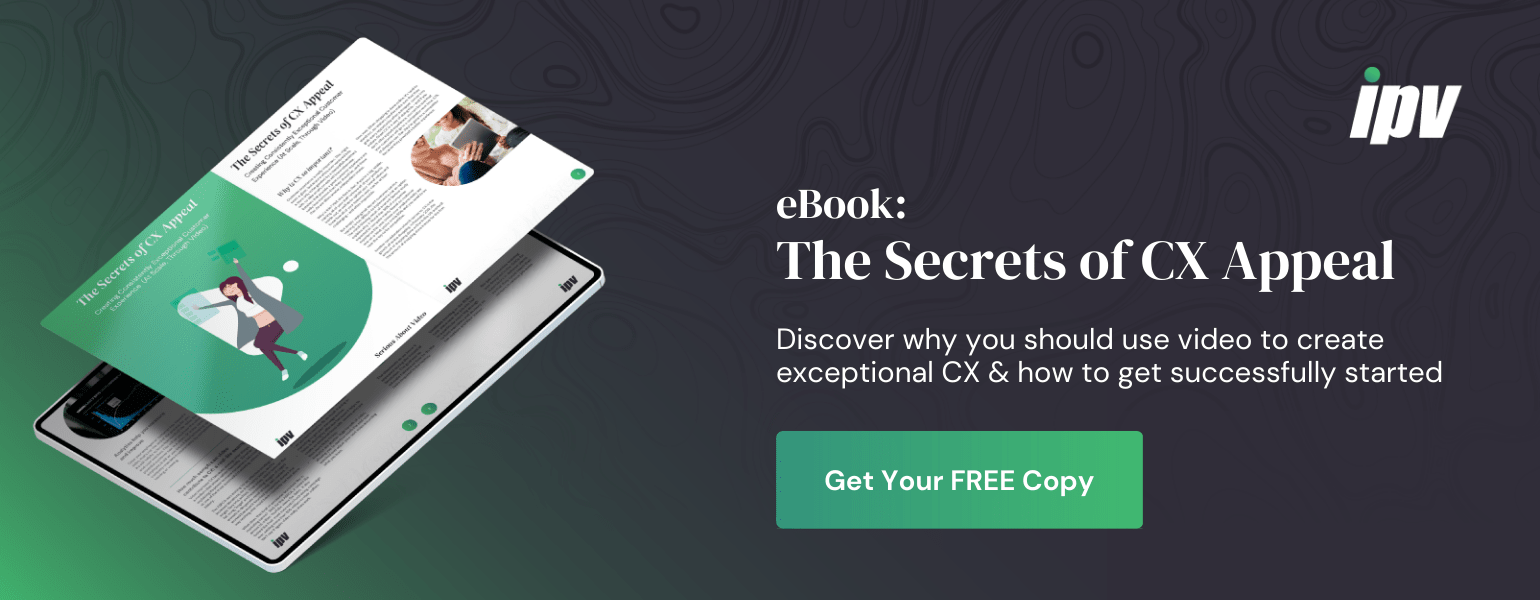How much oomph can video contribute to Customer Experience???
Customer experience is really important. This might seem a given, but anyone who’s ever ventured into a store only to be greeted by a standoffish assistant with no idea what’s on sale will know otherwise. Retailers that provide a great customer experience are sadly less common than they should be...and those that do are often smaller, independent stores.
Why is this? Well, the fact is that, if you’re a big retailer, training all of your staff to know all of your products inside out, as well as to uphold your brand values and know how all of your systems work can be at best challenging - and often impossible.
But simply saying that decent customer service training is too difficult to implement is not an option. The mind-blowing result of a recent Gartner study explains why: it found that 80% of companies expected to compete mainly based on customer experience this year. Unless your products really are one-of-a-kind, you’re in this 80% and you need to be near the top to be competitive.
Another consideration when it comes to CX is the growth of online shopping. In February 2019, the amount of shopping done online in the US overtook the amount of shopping done instore for the first time ever. When shopping is done online, it’s hard to stand out, so retailers need to make sure that they grab every opportunity when a shopper comes into a store. Great CX is a way of doing this - and if you don’t offer a good experience, you can be sure that your customers will go to a competitor next time. 57% of shoppers say that they’ve gone to a competitor because they provided a better experience.

1. Why is video so important for CX?
The increasing use of video for all kinds of communication means that consumers are used to being offered a video whenever they want information or entertainment. Let’s put this in context. YouTube has over a billion users - that’s a third of the users of the whole of the internet. Over 500 million hours of video are watched on YouTube every day. And that’s just on one platform. Video is increasingly our default distraction, the amusement we turn to when we have a spare hour.
In fact, even our spare minutes are being consumed by video. The explosion of video content goes alongside an explosion of new ways to watch it. From VoD to OTT, there’s a host of new technologies designed to allow consumers to access the video they want, when they want it. That might be from a laptop, on a tablet or on a mobile phone on the train to work. Consumers can grab their video fix even if they have 30 seconds till the next stop.
How does all of this link to CX? Well, imagine if you could take this enthusiasm for video and ensure that your company directly benefits from it. It’s clear that video isn’t just for entertainment. If you want to get a message to an audience, video is the way to do it for the very reason that video feels more fun to watch and is easier to absorb. If you want to train your employees to provide good customer service in a way that they might actually enjoy and remember, video is the answer.
The same goes for providing how-to guides and product information for your customers. 100-page manuals are outdated and will only put off consumers, but a short video is not only easier to follow - it’s also more appealing. Creating a series of branded product videos will make your organization look modern and professional, as well as emphasising your brand identity.

2. Why video marketing works so well (This is still about CX!)
Spoiler alert: video marketing works. It works because it presents information in a concise and engaging format for busy consumers. It works because, more than any other strategy, it can create an immediate emotional connection with its viewers, one which builds trust and, for that matter, boosts intended actions like filling out contact forms, downloading critical content and, over time, converting window shoppers into loyal customers.
Said differently, video marketing works because people like video—they like it because it enhances their online experience. Consider these head-turning metrics from WordStream:
• Consumers spend 1/3 of their online time watching videos
• 500 million Facebook users watch videos every day
• More than half of marketers globally say video has the best return on investment (ROI)
• Marketers who leverage video increase revenues 49% faster than those who don't
• Videos increase organic site traffic by an astounding 157%
• Landing page videos increase conversions by on average 80%
Increased availability and accessibility In the past, if you wanted to circulate information to a lot of people quickly, you had to ensure they were either: A) in the same place at the same time, or B) able to receive the information in another form of documentation. But video gives you the flexibility to disseminate information at your end-user's convenience.

3. Video & CX: Why they work so well together
Take, for example, an employee training course. Without video, you would have had to schedule the training session at a time that worked for your employees as well as the training coordinator. You would then have to secure a location to hold the training, ensuring it has the capacity to hold all your participants. From a logistical perspective, it's littered with potential obstacles and challenges that could inhibit the user experience.
With video, you can record the training at the training coordinator's leisure. You can then make the training session available for viewing by the employees whenever its convenient for them. Each one can take the training at their own pace, whenever it works based on their job responsibilities.
It's also great for customer-facing videos. Having a video advertising your company's features, benefits, or testimonials affirming your services can be uploaded at easy-to-find locations such as your website or social media channels. It's then available for your customers to view at any time, spreading your message even further.
This is all true for most companies, but globally located businesses with employees or customers all over the world specifically benefit from communicating via video.
It's repeatable
Video is easy to use and easy to re-watch. If your customers or employees missed a key concept on the first viewing, they can simply watch the video again whenever they want.
From a content-development standpoint, video is also an efficient tool. If you're recording a video that needs to be re-used on a recurring basis, it's easy to make updates. You simply edit the portion of the video that needs to be changed and re-use it. The rest of the content you've already spent time and money to produce doesn't go anywhere.
Let's say you push out an annual video in which you list off your company's achievements for the calendar year. Some of the benchmarks and goals you set are similar, but maybe the numbers change on a yearly basis. Creating a video in which you show your progress in these different categories, updating only the statistics, could be a standing part of your team's content year after year.
If you opt to use materials you'll need to recreate each time you revisit a certain topic, it can take up too much of your valuable time. That's time that could be spent on other responsibilities. Opting for video could also save you money - another great reason to consider video as an option.
Video is both more effective and cost-effective than text
Videos are relatively inexpensive to produce and on average have outstanding return on investment (ROI), with 66% of marketers getting more leads using video, not to mention a 54% increase in brand awareness. They’re also more effective than text because it's easier for consumers to remember them. Several studies have demonstrated for example that consumers retain about 95% of the messages contained in videos compared to just 10% for text alone.
There are many more reasons video is so powerful in enriching customer experience. For one thing, its versatility makes it work throughout the buyer's journey as it effectively generates and nurtures leads, enhances product presentations and bolsters social proof. For another, it helps consumers click with your brand naturally and immediately, giving a face as it were to your business.
Finally, it's important to consider that, although people justify their purchasing decisions based on logic, they make those decisions based on emotion. Your neighbor might tell you he picked up his shiny new convertible because it gets good mileage, but you know he's getting a kick out of the envy you feel every morning when you see it smirking at you in his driveway. Consumers like appeals to their emotions, and nothing creates an immediate emotional bond better than a well-crafted video.
Analytics help you measure and improve
Once your employee or customer has viewed a video, that's not the end of the process for you. It's still helpful to know how much of the video the end-user watched. This will let you know the value a potential customer saw in a video. Or in the case of an employee, it will let you know if they're keeping up with company-mandated requirements by completing a training or viewing.
Using video for CX enables you to view your analytics so you can know how effective your video was at its intended goal. You'll have quantifiable metrics you can use to determine how successful your video was in reaching your end-user, whether that's a customer or an employee. It also allows you to fine-tune your approach after the fact. Your video's analytics provide you with data to enhance your future customer experience while also evaluating your current performance.

4. How much oomph can video contribute to CX: a real-life example
Video improves CX because, among other things, it's a medium that shows rather than tells. So rather than explaining its power to move consumers, let's look at one of the most successful marketing videos in history.
The ASPCA was looking for an effective strategy to increase donations, so it turned to video, and to singer, Sara McLachlan. That video, which features the hit-song, "Angel" and heartrending images of caged animals in desperate need of help, well, worked. It worked because it touched prospective donors in a way nothing else could have—certainly not text alone.
What does that kind of emotional bond look like in marketing terms? Well, for the ASPCA, it looked like almost 1.5 million YouTube views (to date). It also looked like their most successful fundraising campaign ever, adding more than $30 million to their coffers. We’ll say it again: video really does work.
Key takeaways
• Video is a great way of ensuring that your training is available to anyone, anywhere. This helps you to provide great CX by training all of your employees in exactly the same way.
• The ability to edit and reuse videos will allow you to keep your training materials up-to-date without lots of additional time and money.
• Video can also be cost-effective because it is processed faster and recalled better than text - so you won’t need to do as much training or marketing to get your message across.
• Video is also highly effective because it helps to create an emotional bond with viewers, who are then more likely to buy.
• Analytics are another huge benefit of video, allowing you to see how much the end-user watched and adjust your next video according what you learn.
Recommended reading

DAM vs MAM vs VAM: your guide to media asset management
When an industry becomes entrenched with jargon, it can become really confusing. This is doubly true when people are inconsistent with how these terms are used.

Infront Sports Media score with intelligent video content platform
As the broadcast home to incredibly popular sporting brands such as Serie A, the Italian soccer league, Infront Sports Media has positioned itself as one of the most innovative sports broadcasters in the world today.

Object recognition and the future of video asset management
The future is video. And for creators and consumers of video content, the future is bright… Or at least it has the capacity to be.

